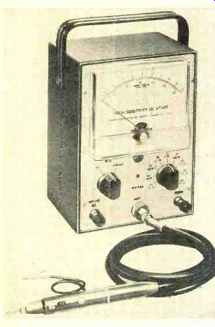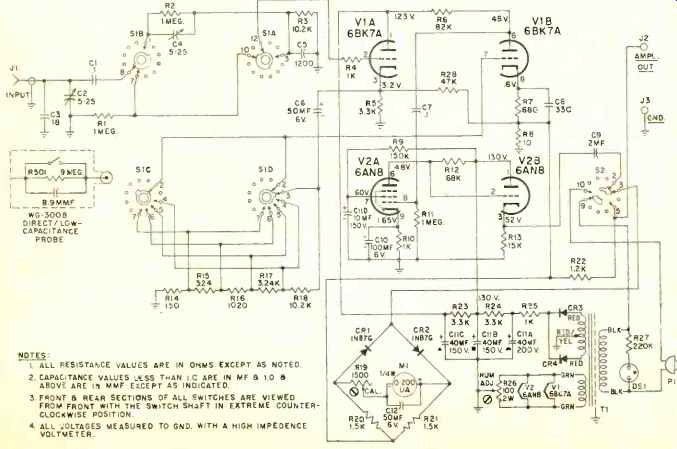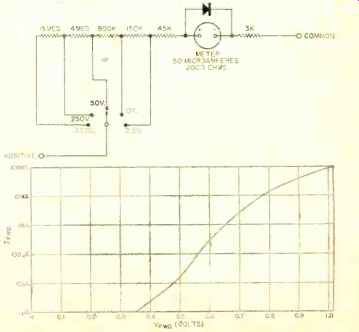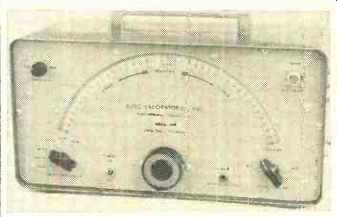(source: Electronics World, Dec. 1963)
RCA WV-76A A.C. V.T.V.M.


FOR years, the audio voltmeter has been restricted to the designer's bench or sound studio by specialized applications and "laboratory" prices.
Today's tremendous hi-fi market, however, has brought audio servicing-and the audio voltmeter-right into the neighborhood TV-audio service shop.
One of the most recent instruments--the RCA WV-76A high-sensitivity a.c. v.t.v.m. symbolizes the design trend toward higher performance and lower cost. Because it is .a vacuum-tube voltmeter, the WV-76A has many inherent advantages. Included are protection against meter burnout, high input impedance to minimize test-circuit loading, wide frequency response on a.c. voltage measurements, very high sensitivity to low signal levels, excellent stability, and -- of primary importance good over-- all measurement accuracy.
These features enable the service technician to troubleshoot and adjust almost any audio component, such as phono cartridges, tape heads, preamplifiers, power amplifiers, tone control and mixer circuits, and audio networks of all types. The instrument is also an invaluable aid in balancing stereo channels and determining the frequency response of circuits and systems.
Three basic functions are provided: (1) a.c. voltage measurements from 0.0002 volt (lowest scale division) to 100 volts in nine overlapping ranges; (2) direct decibel readings from-40 to +40 db in nine ranges for measuring stage or over-all amplifier gain; and (3) an auxiliary amplifier function having 38-db gain. This last feature makes the WV-76A usable as a flat-response preamplifier for low-gain audio systems or oscilloscopes. All readings are taken from a 4 1/2" meter having only two basic scales.
Frequency response-- a limiting factor with most a.c. voltmeters-- is flat within 1 db from 10 cps to 1.5 megacycles.
Full-scale instrument accuracy on all 18 voltage and decibel ranges is ± 5% or better--which is more than adequate for general service and laboratory use.
A contributing factor to high performance is a switch-type direct /low-capacitance probe and shielded cable. In the low-C position of the probe switch, the WV-76A presents 10 megohms of input resistance shunted by only 13 pf. of capacitance. The low-capacitance function also extends the voltage and decibel ranges to 500 volts and +56 db.
Four stages are used for maximum stability and sensitivity. The input signal is fed into a cathode follower, V1A (see figure) . Voltages from 3 to 100 volts are passed through a precision attenuator ahead of V1A. On the 10millivolt to 1-volt ranges, the signal is attenuated between V1A and the first amplifier stage, V1B. The a.c. output from V1B is further amplified in V2A and fed to the second cathode follower, V2B. The output is then applied to a meter through a half-bridge circuit. A feedback loop from the meter circuit to the first amplifier stage provides additional stability and linearity. Heavy filtering in the power supply and a hum-adjustment potentiometer in the tube-heater circuit effectively eliminate hum.
The optional user price for the factory-wired version of the instrument is $79.95. It is also available in kit form at an optional user price of $57.95.
Prices include the probe.
----------------------
Simpson Model 261 V.O.M.


For copy of manufacturer's brochure, circle No. 59 on coupon (page 15). ANEW multi-range v.o.m., the Model 261, has been introduced by Simpson to answer the need for a more accurate, moderately priced instrument. The meter has a sensitivity of 20,000 ohms per volt on d.c. and 5000 ohms per volt on a.c. Its accuracy is 11% or better of full scale for d.c., and 3% or better of full scale for a.c. On the lowest current range, the accuracy is that of the movement itself-1 %. The accuracy of the meter makes it more useful for design work where exact values must be determined rather than just an indication that the parameter under test is "about normal." The instrument has the usual a.c. and d.c. voltage ranges, as well as d.c. current, decibel, and resistance scales.
An interesting feature of the Model 261 is the built-in overload protection.
As shown in the schematic, the movement has a resistance of about 2000 ohms and a full-scale sensitivity of 50µa.
Therefore, at full-scale deflection, the voltage drop across the movement will be about 0.1 v. The movement overload protection is provided by the diode connected (in the forward direction)
in parallel with the movement. As shown in the graph, essentially no forward current will flow through the diode when rated current passes through the movement. If an overload of 2000 times rated (100 ma. ) is applied to the metering circuit, most of the current will flow through the diode. With 100 ma. of diode current, the voltage drop across the diode and across the movement will be 1.02 volts. This means that the movement will have a current of 510 µa. flowing through it. Thus, with an applied overload of about 2000 times, the movement is subjected to an overload of only 10 times rated. This small overload will not cause damage to the movement even if applied continuously.
The Model 261 also includes a mirror scale and knife-edge pointer to insure highest accuracy of reading. For example, because of parallax, it is quite possible that the indicated reading might be displaced 1 /le" from the true reading. This small reading error corresponds to a reading that is off by 1.71% of full scale. Since 1.71% is greater than the d.c. accuracy of 1.5 %, it is obvious that it is essential that parallax errors be minimized by use of a mirror scale.
Although generally not recognized, the Model 261 (or any 20,000 ohms per volt v.o.m.) has a higher input impedance on the 1000-volt d.c. range than most v.t.v.m.'s. The input impedance on this range is 20 meg., which allows reading voltages in very high impedance circuits. Since each division on the range corresponds to 20 volts, it is possible to read voltages as low as about 10 volts on the 1000-volt range with virtually no circuit-loading effect.
In addition to the features mentioned above, the meter uses a self-shielded movement that is not affected by outside magnetic materials or fields. Spring backed jewels are used so that the movement will withstand greater shock and vibration without damage.
The Model 261 measures 5.25" x 7" x 3.2" and weighs 3.5 lbs. It is available at $59.95 from electronic parts distributors.
----------------
Eltec Model 600 Frequency Standard

In order to take accurate measurements of receiver and transmitter frequencies, some sort of frequency standard is required. The Eltec Model 600 combines the principles used in a heterodyne frequency meter and a highly accurate crystal calibrator in order to check frequencies in the 25- to 54-mc. range. Hence, the instrument can be used to accurately set the frequency of Citizens Band equipment and low band equipment operating in the two way radio service. The accuracy of the instrument is .0002 percent, exceeding FCC requirements by five times. The unit can also be used from 10 kc. upward in amateur radio applications, such as in checking 100-kc. calibrators and spot checking frequencies up to 54 mc.
Heart of the instrument is an accurate 100-kc. crystal, which is mounted within a thermostatically controlled oven to maintain its temperature and its operating frequency. Although highly stable, it is suggested that the circuit be checked against WWV regularly to make sure of its setting. A built-in audio detector, amplifier, and speaker are used in order to respond to the beat note generated by the instrument's oscillator mixing with the output of a transmitter.
When receiver circuits are to be adjusted, it is common to use the receiver's audio circuits for this purpose.
In addition to the 100-kc. output of the instrument, four other oscillator frequencies are available that are locked to the 100-kc. crystal oscillator. These are 10 kc., 20 kc., 25 kc., and 50 kc. As a result, harmonic frequencies are generated that are separated from each other by 10, 20, 25, 50, or 100 kc. Since all assigned frequencies in the 30-50 mc. two-way radio band are exactly divisible by 20 kc., all receivers and transmitters in this band can be set and aligned to their exact frequencies with the Model 600 set to its 20-kc. output.
Since the crystal trimmers in commercial transmitters cannot vary the frequency by more than about 5 kc., there is no chance of reading the wrong harmonic.
In the Citizens Band, however, most frequencies are not exactly divisible by any of the above frequencies. To cover these channels, the instrument's deviation control is adjusted. This permits the user to select any frequency between two of the locked-oscillator harmonics. Deviation dial settings for these intermediate frequencies are shown in an individually hand-calibrated chart supplied with the unit. Hence, it is not necessary to use mathematics or interpolations.
The Model 600 is available from the manufacturer at $349.95.
REVISED STANDARDS
The Defense Electronics Supply Center has announced the availability of nine new and revised specifications and standards which received approval in July. All of the documents listed below can be obtained from the Naval Supply Depot, 5801 Tabor Avenue, Philadelphia, Pa.
MIL-E-1/89 Revision C: Electron Tube, Receiving, JAN5787WA (for BuShips).
MIL-E1/1333 Revision C: Electron Tube, Receiving JAN-7266 (for BuShips) .
MIL-E1/639, Revision C: Electron Tube, Receiving JAN-12AY7 (for Buships).
MIL-E-1 /940, Revision E: Electron Tube, Receiving JAN-OB2WA (Equivalent to JAN-6627) (for BuShips).
MIL-E1/1225, Revision A: Electron Tube Receiving Pentode, Miniature JAN-6688 (for BuShips).
MIL-E-1/1416, Revision A: Electron Tube, Receiving JAN-6900 (for BuShips).
MS 24655, Revision B: Switch, Toggle, Miniature Aircraft, Single Pole, One Hole Mounting (for USAF).
MS 24656, Revision B: Switch, Toggle, Miniature Aircraft, Double Pole, One Hole Mounting (for USAF).